Analyzing Business Environments in Small and Medium Enterprises
VerifiedAdded on 2020/06/03
|11
|3472
|81
AI Summary
The analysis examines SMEs' approaches to understanding and responding to their business environments. It delves into how these enterprises manage external factors like market trends and competition through strategic planning and innovation. The study also considers the impact of organizational culture and entrepreneurial orientation on SME performance. Key concepts include environmental uncertainty, corporate-NGO collaboration, and service development in capital goods manufacturing. References are drawn from multiple case studies and research articles that discuss business model adaptation, leadership skills development, and the role of information systems in aligning business goals with IT capabilities.
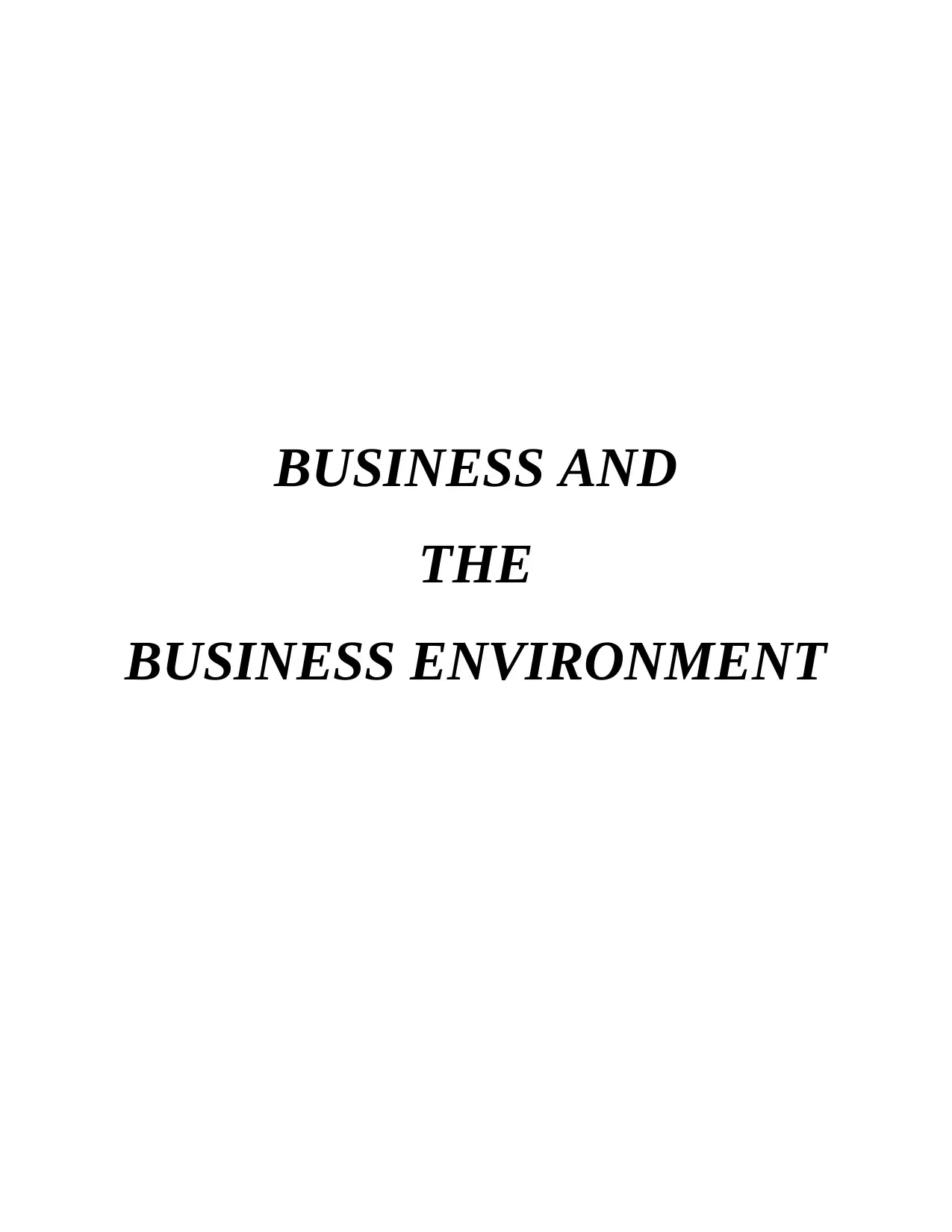
BUSINESS AND
THE
BUSINESS ENVIRONMENT
THE
BUSINESS ENVIRONMENT
Paraphrase This Document
Need a fresh take? Get an instant paraphrase of this document with our AI Paraphraser
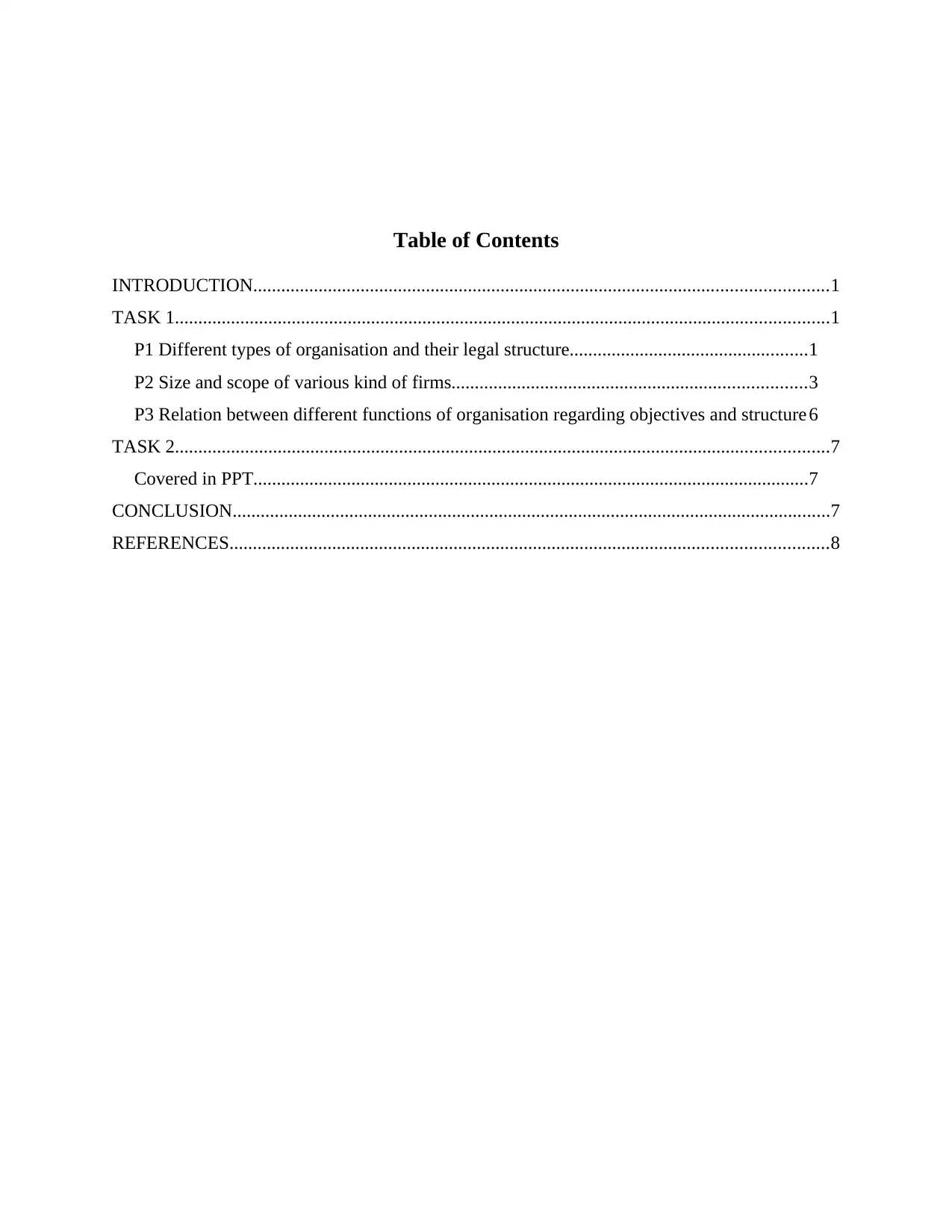
Table of Contents
INTRODUCTION...........................................................................................................................1
TASK 1............................................................................................................................................1
P1 Different types of organisation and their legal structure...................................................1
P2 Size and scope of various kind of firms............................................................................3
P3 Relation between different functions of organisation regarding objectives and structure 6
TASK 2............................................................................................................................................7
Covered in PPT.......................................................................................................................7
CONCLUSION................................................................................................................................7
REFERENCES................................................................................................................................8
INTRODUCTION...........................................................................................................................1
TASK 1............................................................................................................................................1
P1 Different types of organisation and their legal structure...................................................1
P2 Size and scope of various kind of firms............................................................................3
P3 Relation between different functions of organisation regarding objectives and structure 6
TASK 2............................................................................................................................................7
Covered in PPT.......................................................................................................................7
CONCLUSION................................................................................................................................7
REFERENCES................................................................................................................................8
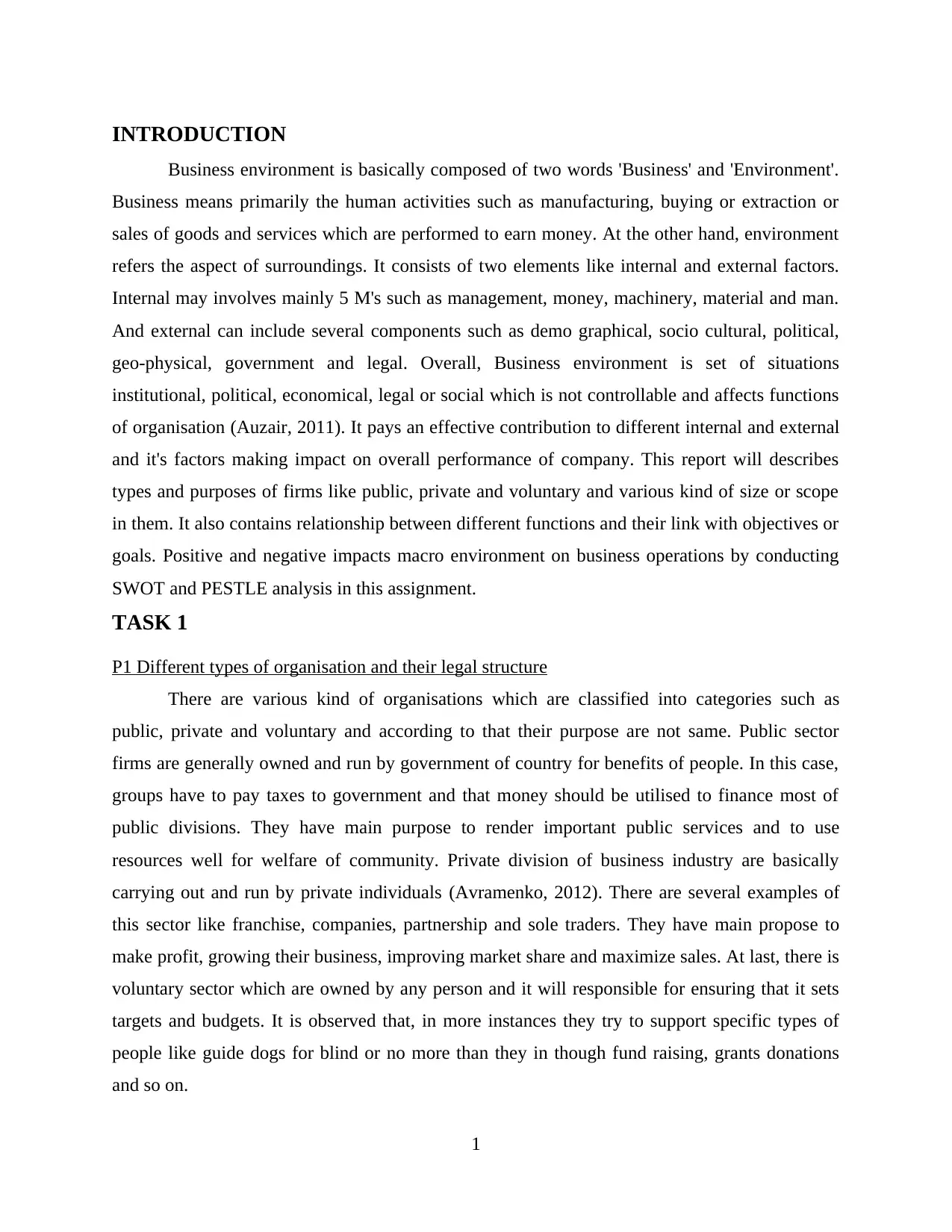
INTRODUCTION
Business environment is basically composed of two words 'Business' and 'Environment'.
Business means primarily the human activities such as manufacturing, buying or extraction or
sales of goods and services which are performed to earn money. At the other hand, environment
refers the aspect of surroundings. It consists of two elements like internal and external factors.
Internal may involves mainly 5 M's such as management, money, machinery, material and man.
And external can include several components such as demo graphical, socio cultural, political,
geo-physical, government and legal. Overall, Business environment is set of situations
institutional, political, economical, legal or social which is not controllable and affects functions
of organisation (Auzair, 2011). It pays an effective contribution to different internal and external
and it's factors making impact on overall performance of company. This report will describes
types and purposes of firms like public, private and voluntary and various kind of size or scope
in them. It also contains relationship between different functions and their link with objectives or
goals. Positive and negative impacts macro environment on business operations by conducting
SWOT and PESTLE analysis in this assignment.
TASK 1
P1 Different types of organisation and their legal structure
There are various kind of organisations which are classified into categories such as
public, private and voluntary and according to that their purpose are not same. Public sector
firms are generally owned and run by government of country for benefits of people. In this case,
groups have to pay taxes to government and that money should be utilised to finance most of
public divisions. They have main purpose to render important public services and to use
resources well for welfare of community. Private division of business industry are basically
carrying out and run by private individuals (Avramenko, 2012). There are several examples of
this sector like franchise, companies, partnership and sole traders. They have main propose to
make profit, growing their business, improving market share and maximize sales. At last, there is
voluntary sector which are owned by any person and it will responsible for ensuring that it sets
targets and budgets. It is observed that, in more instances they try to support specific types of
people like guide dogs for blind or no more than they in though fund raising, grants donations
and so on.
1
Business environment is basically composed of two words 'Business' and 'Environment'.
Business means primarily the human activities such as manufacturing, buying or extraction or
sales of goods and services which are performed to earn money. At the other hand, environment
refers the aspect of surroundings. It consists of two elements like internal and external factors.
Internal may involves mainly 5 M's such as management, money, machinery, material and man.
And external can include several components such as demo graphical, socio cultural, political,
geo-physical, government and legal. Overall, Business environment is set of situations
institutional, political, economical, legal or social which is not controllable and affects functions
of organisation (Auzair, 2011). It pays an effective contribution to different internal and external
and it's factors making impact on overall performance of company. This report will describes
types and purposes of firms like public, private and voluntary and various kind of size or scope
in them. It also contains relationship between different functions and their link with objectives or
goals. Positive and negative impacts macro environment on business operations by conducting
SWOT and PESTLE analysis in this assignment.
TASK 1
P1 Different types of organisation and their legal structure
There are various kind of organisations which are classified into categories such as
public, private and voluntary and according to that their purpose are not same. Public sector
firms are generally owned and run by government of country for benefits of people. In this case,
groups have to pay taxes to government and that money should be utilised to finance most of
public divisions. They have main purpose to render important public services and to use
resources well for welfare of community. Private division of business industry are basically
carrying out and run by private individuals (Avramenko, 2012). There are several examples of
this sector like franchise, companies, partnership and sole traders. They have main propose to
make profit, growing their business, improving market share and maximize sales. At last, there is
voluntary sector which are owned by any person and it will responsible for ensuring that it sets
targets and budgets. It is observed that, in more instances they try to support specific types of
people like guide dogs for blind or no more than they in though fund raising, grants donations
and so on.
1
⊘ This is a preview!⊘
Do you want full access?
Subscribe today to unlock all pages.

Trusted by 1+ million students worldwide
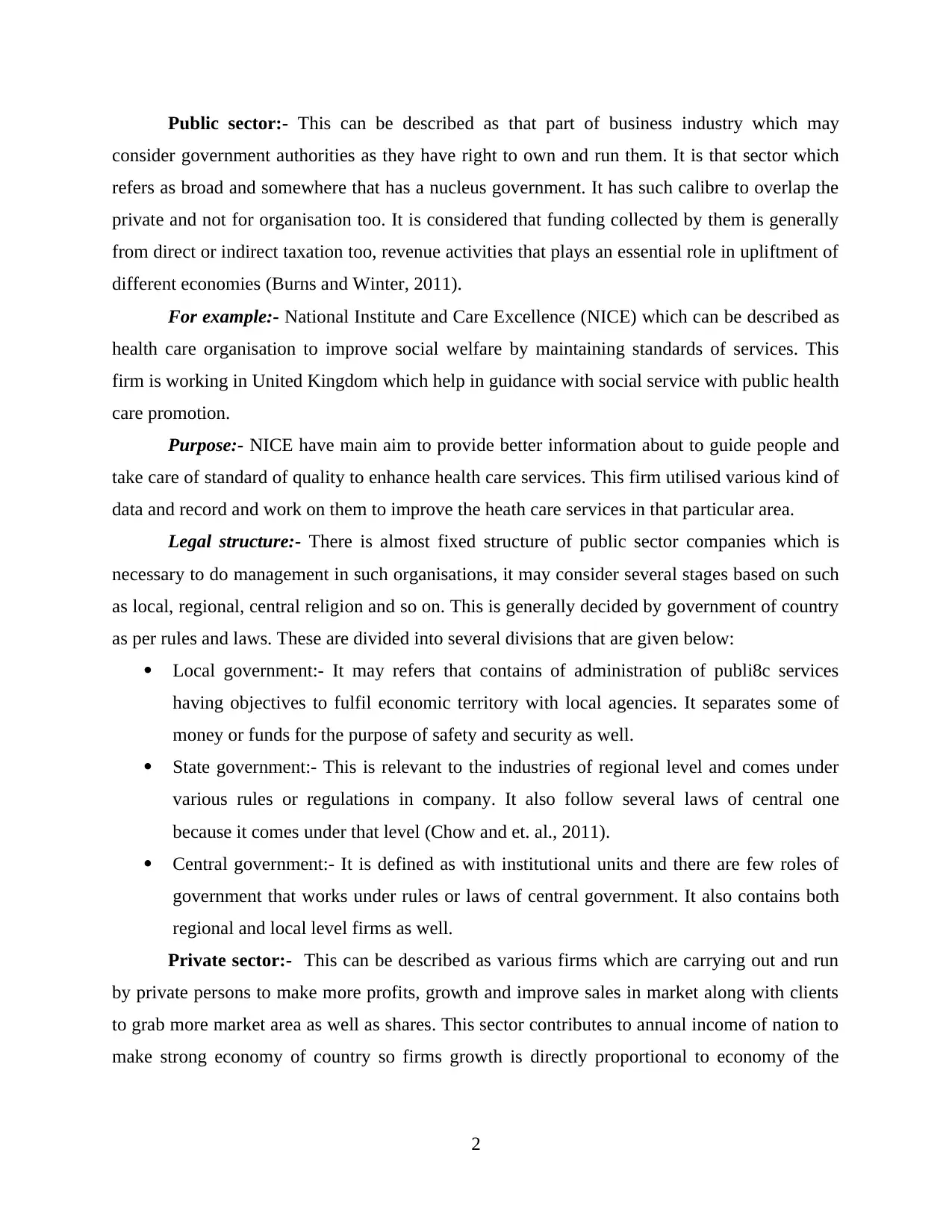
Public sector:- This can be described as that part of business industry which may
consider government authorities as they have right to own and run them. It is that sector which
refers as broad and somewhere that has a nucleus government. It has such calibre to overlap the
private and not for organisation too. It is considered that funding collected by them is generally
from direct or indirect taxation too, revenue activities that plays an essential role in upliftment of
different economies (Burns and Winter, 2011).
For example:- National Institute and Care Excellence (NICE) which can be described as
health care organisation to improve social welfare by maintaining standards of services. This
firm is working in United Kingdom which help in guidance with social service with public health
care promotion.
Purpose:- NICE have main aim to provide better information about to guide people and
take care of standard of quality to enhance health care services. This firm utilised various kind of
data and record and work on them to improve the heath care services in that particular area.
Legal structure:- There is almost fixed structure of public sector companies which is
necessary to do management in such organisations, it may consider several stages based on such
as local, regional, central religion and so on. This is generally decided by government of country
as per rules and laws. These are divided into several divisions that are given below:
Local government:- It may refers that contains of administration of publi8c services
having objectives to fulfil economic territory with local agencies. It separates some of
money or funds for the purpose of safety and security as well.
State government:- This is relevant to the industries of regional level and comes under
various rules or regulations in company. It also follow several laws of central one
because it comes under that level (Chow and et. al., 2011).
Central government:- It is defined as with institutional units and there are few roles of
government that works under rules or laws of central government. It also contains both
regional and local level firms as well.
Private sector:- This can be described as various firms which are carrying out and run
by private persons to make more profits, growth and improve sales in market along with clients
to grab more market area as well as shares. This sector contributes to annual income of nation to
make strong economy of country so firms growth is directly proportional to economy of the
2
consider government authorities as they have right to own and run them. It is that sector which
refers as broad and somewhere that has a nucleus government. It has such calibre to overlap the
private and not for organisation too. It is considered that funding collected by them is generally
from direct or indirect taxation too, revenue activities that plays an essential role in upliftment of
different economies (Burns and Winter, 2011).
For example:- National Institute and Care Excellence (NICE) which can be described as
health care organisation to improve social welfare by maintaining standards of services. This
firm is working in United Kingdom which help in guidance with social service with public health
care promotion.
Purpose:- NICE have main aim to provide better information about to guide people and
take care of standard of quality to enhance health care services. This firm utilised various kind of
data and record and work on them to improve the heath care services in that particular area.
Legal structure:- There is almost fixed structure of public sector companies which is
necessary to do management in such organisations, it may consider several stages based on such
as local, regional, central religion and so on. This is generally decided by government of country
as per rules and laws. These are divided into several divisions that are given below:
Local government:- It may refers that contains of administration of publi8c services
having objectives to fulfil economic territory with local agencies. It separates some of
money or funds for the purpose of safety and security as well.
State government:- This is relevant to the industries of regional level and comes under
various rules or regulations in company. It also follow several laws of central one
because it comes under that level (Chow and et. al., 2011).
Central government:- It is defined as with institutional units and there are few roles of
government that works under rules or laws of central government. It also contains both
regional and local level firms as well.
Private sector:- This can be described as various firms which are carrying out and run
by private persons to make more profits, growth and improve sales in market along with clients
to grab more market area as well as shares. This sector contributes to annual income of nation to
make strong economy of country so firms growth is directly proportional to economy of the
2
Paraphrase This Document
Need a fresh take? Get an instant paraphrase of this document with our AI Paraphraser
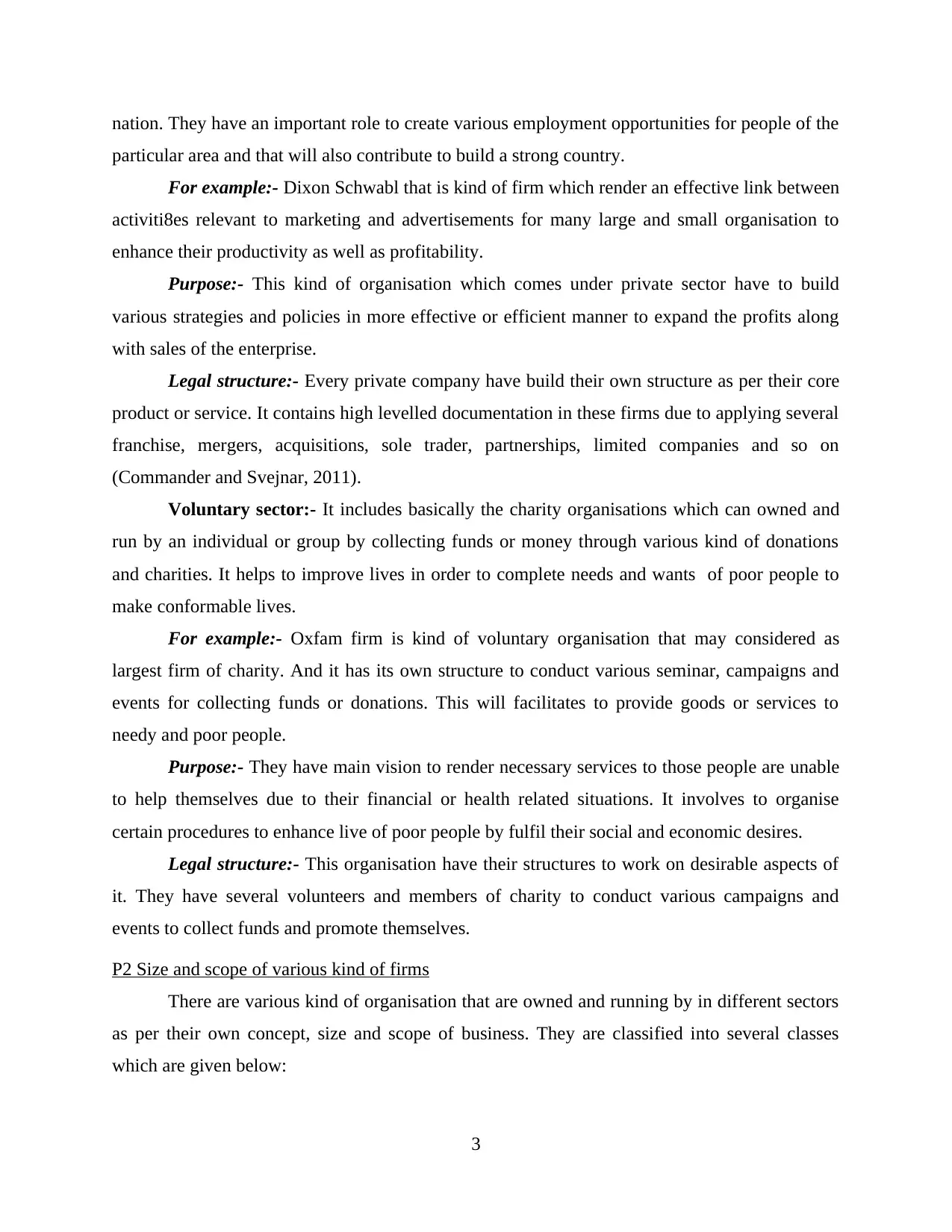
nation. They have an important role to create various employment opportunities for people of the
particular area and that will also contribute to build a strong country.
For example:- Dixon Schwabl that is kind of firm which render an effective link between
activiti8es relevant to marketing and advertisements for many large and small organisation to
enhance their productivity as well as profitability.
Purpose:- This kind of organisation which comes under private sector have to build
various strategies and policies in more effective or efficient manner to expand the profits along
with sales of the enterprise.
Legal structure:- Every private company have build their own structure as per their core
product or service. It contains high levelled documentation in these firms due to applying several
franchise, mergers, acquisitions, sole trader, partnerships, limited companies and so on
(Commander and Svejnar, 2011).
Voluntary sector:- It includes basically the charity organisations which can owned and
run by an individual or group by collecting funds or money through various kind of donations
and charities. It helps to improve lives in order to complete needs and wants of poor people to
make conformable lives.
For example:- Oxfam firm is kind of voluntary organisation that may considered as
largest firm of charity. And it has its own structure to conduct various seminar, campaigns and
events for collecting funds or donations. This will facilitates to provide goods or services to
needy and poor people.
Purpose:- They have main vision to render necessary services to those people are unable
to help themselves due to their financial or health related situations. It involves to organise
certain procedures to enhance live of poor people by fulfil their social and economic desires.
Legal structure:- This organisation have their structures to work on desirable aspects of
it. They have several volunteers and members of charity to conduct various campaigns and
events to collect funds and promote themselves.
P2 Size and scope of various kind of firms
There are various kind of organisation that are owned and running by in different sectors
as per their own concept, size and scope of business. They are classified into several classes
which are given below:
3
particular area and that will also contribute to build a strong country.
For example:- Dixon Schwabl that is kind of firm which render an effective link between
activiti8es relevant to marketing and advertisements for many large and small organisation to
enhance their productivity as well as profitability.
Purpose:- This kind of organisation which comes under private sector have to build
various strategies and policies in more effective or efficient manner to expand the profits along
with sales of the enterprise.
Legal structure:- Every private company have build their own structure as per their core
product or service. It contains high levelled documentation in these firms due to applying several
franchise, mergers, acquisitions, sole trader, partnerships, limited companies and so on
(Commander and Svejnar, 2011).
Voluntary sector:- It includes basically the charity organisations which can owned and
run by an individual or group by collecting funds or money through various kind of donations
and charities. It helps to improve lives in order to complete needs and wants of poor people to
make conformable lives.
For example:- Oxfam firm is kind of voluntary organisation that may considered as
largest firm of charity. And it has its own structure to conduct various seminar, campaigns and
events for collecting funds or donations. This will facilitates to provide goods or services to
needy and poor people.
Purpose:- They have main vision to render necessary services to those people are unable
to help themselves due to their financial or health related situations. It involves to organise
certain procedures to enhance live of poor people by fulfil their social and economic desires.
Legal structure:- This organisation have their structures to work on desirable aspects of
it. They have several volunteers and members of charity to conduct various campaigns and
events to collect funds and promote themselves.
P2 Size and scope of various kind of firms
There are various kind of organisation that are owned and running by in different sectors
as per their own concept, size and scope of business. They are classified into several classes
which are given below:
3
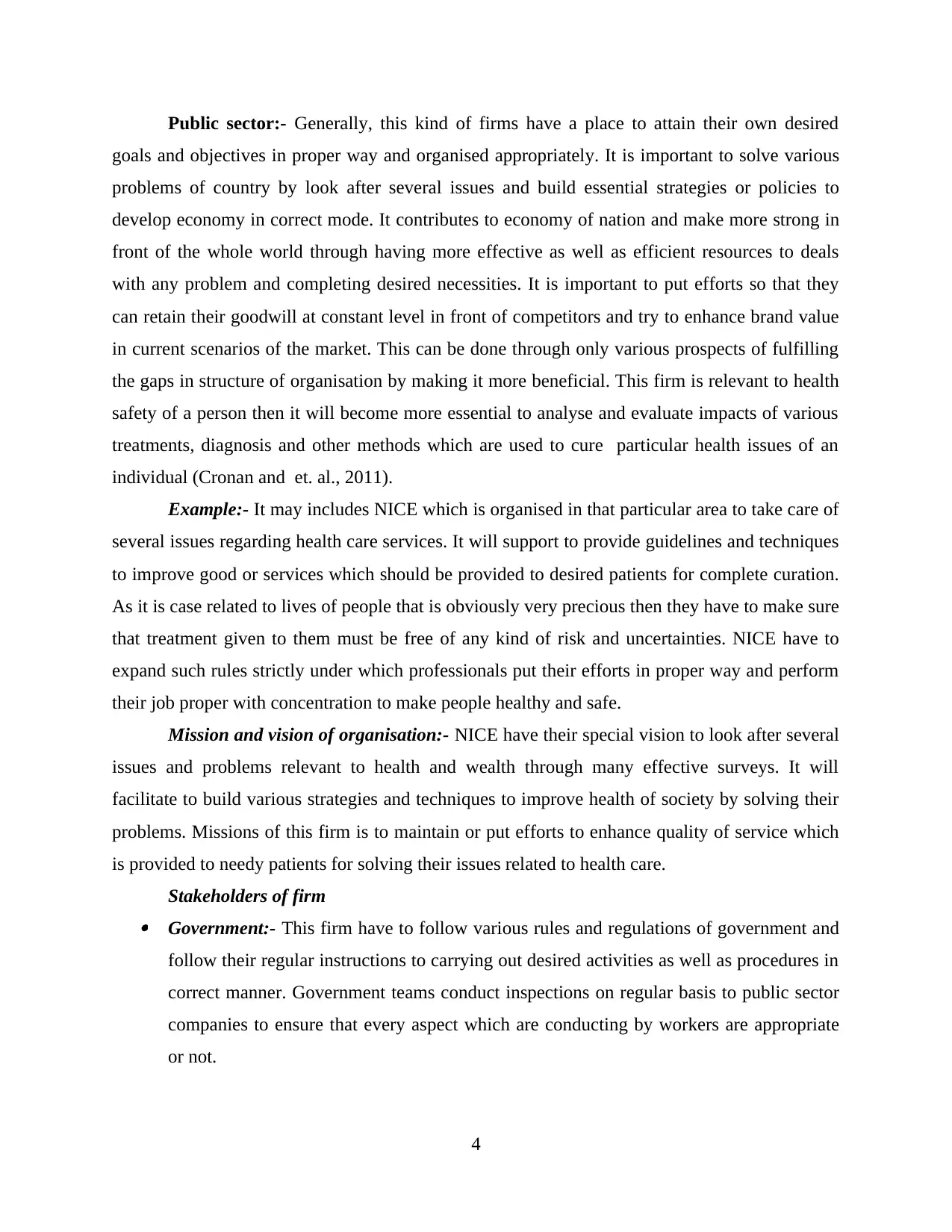
Public sector:- Generally, this kind of firms have a place to attain their own desired
goals and objectives in proper way and organised appropriately. It is important to solve various
problems of country by look after several issues and build essential strategies or policies to
develop economy in correct mode. It contributes to economy of nation and make more strong in
front of the whole world through having more effective as well as efficient resources to deals
with any problem and completing desired necessities. It is important to put efforts so that they
can retain their goodwill at constant level in front of competitors and try to enhance brand value
in current scenarios of the market. This can be done through only various prospects of fulfilling
the gaps in structure of organisation by making it more beneficial. This firm is relevant to health
safety of a person then it will become more essential to analyse and evaluate impacts of various
treatments, diagnosis and other methods which are used to cure particular health issues of an
individual (Cronan and et. al., 2011).
Example:- It may includes NICE which is organised in that particular area to take care of
several issues regarding health care services. It will support to provide guidelines and techniques
to improve good or services which should be provided to desired patients for complete curation.
As it is case related to lives of people that is obviously very precious then they have to make sure
that treatment given to them must be free of any kind of risk and uncertainties. NICE have to
expand such rules strictly under which professionals put their efforts in proper way and perform
their job proper with concentration to make people healthy and safe.
Mission and vision of organisation:- NICE have their special vision to look after several
issues and problems relevant to health and wealth through many effective surveys. It will
facilitate to build various strategies and techniques to improve health of society by solving their
problems. Missions of this firm is to maintain or put efforts to enhance quality of service which
is provided to needy patients for solving their issues related to health care.
Stakeholders of firm Government:- This firm have to follow various rules and regulations of government and
follow their regular instructions to carrying out desired activities as well as procedures in
correct manner. Government teams conduct inspections on regular basis to public sector
companies to ensure that every aspect which are conducting by workers are appropriate
or not.
4
goals and objectives in proper way and organised appropriately. It is important to solve various
problems of country by look after several issues and build essential strategies or policies to
develop economy in correct mode. It contributes to economy of nation and make more strong in
front of the whole world through having more effective as well as efficient resources to deals
with any problem and completing desired necessities. It is important to put efforts so that they
can retain their goodwill at constant level in front of competitors and try to enhance brand value
in current scenarios of the market. This can be done through only various prospects of fulfilling
the gaps in structure of organisation by making it more beneficial. This firm is relevant to health
safety of a person then it will become more essential to analyse and evaluate impacts of various
treatments, diagnosis and other methods which are used to cure particular health issues of an
individual (Cronan and et. al., 2011).
Example:- It may includes NICE which is organised in that particular area to take care of
several issues regarding health care services. It will support to provide guidelines and techniques
to improve good or services which should be provided to desired patients for complete curation.
As it is case related to lives of people that is obviously very precious then they have to make sure
that treatment given to them must be free of any kind of risk and uncertainties. NICE have to
expand such rules strictly under which professionals put their efforts in proper way and perform
their job proper with concentration to make people healthy and safe.
Mission and vision of organisation:- NICE have their special vision to look after several
issues and problems relevant to health and wealth through many effective surveys. It will
facilitate to build various strategies and techniques to improve health of society by solving their
problems. Missions of this firm is to maintain or put efforts to enhance quality of service which
is provided to needy patients for solving their issues related to health care.
Stakeholders of firm Government:- This firm have to follow various rules and regulations of government and
follow their regular instructions to carrying out desired activities as well as procedures in
correct manner. Government teams conduct inspections on regular basis to public sector
companies to ensure that every aspect which are conducting by workers are appropriate
or not.
4
⊘ This is a preview!⊘
Do you want full access?
Subscribe today to unlock all pages.

Trusted by 1+ million students worldwide
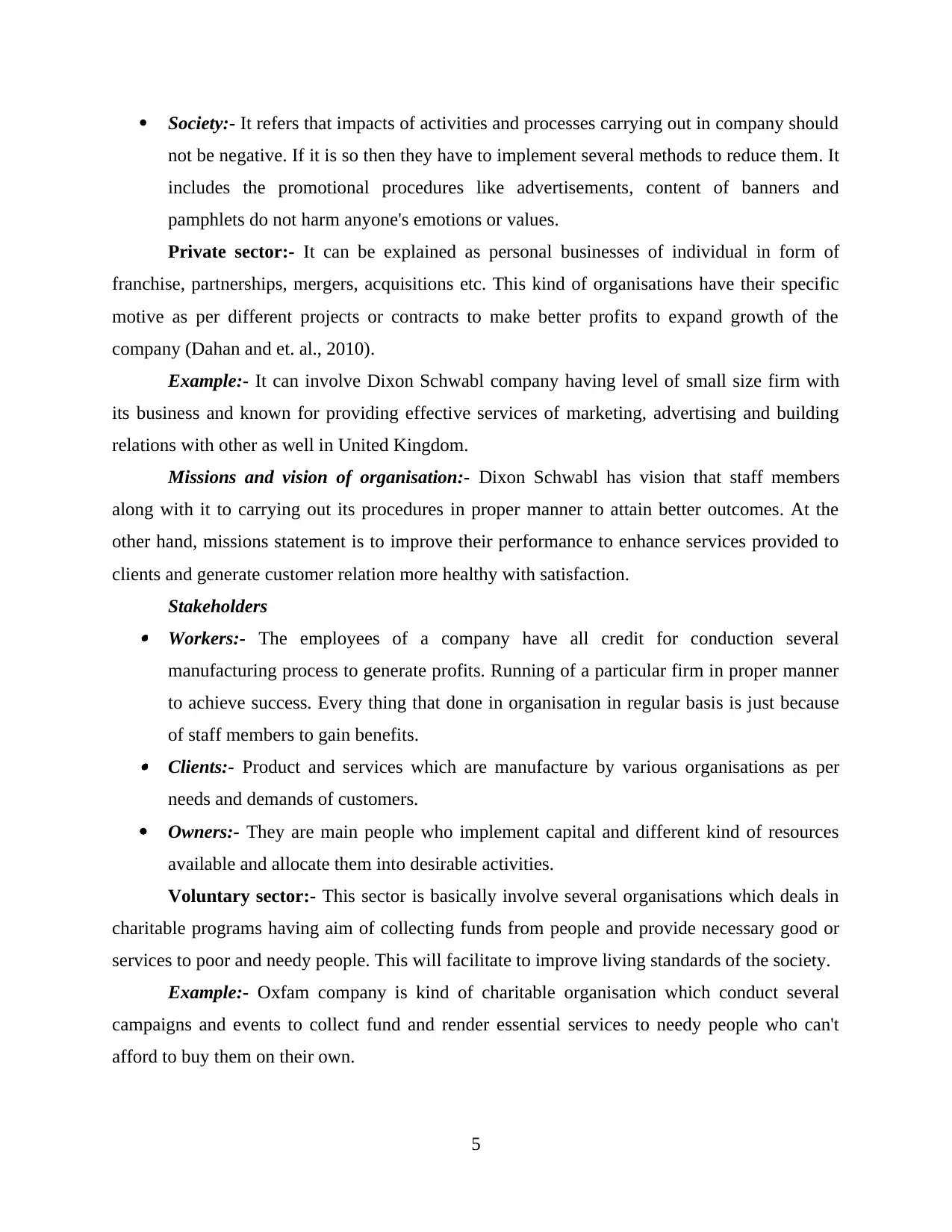
Society:- It refers that impacts of activities and processes carrying out in company should
not be negative. If it is so then they have to implement several methods to reduce them. It
includes the promotional procedures like advertisements, content of banners and
pamphlets do not harm anyone's emotions or values.
Private sector:- It can be explained as personal businesses of individual in form of
franchise, partnerships, mergers, acquisitions etc. This kind of organisations have their specific
motive as per different projects or contracts to make better profits to expand growth of the
company (Dahan and et. al., 2010).
Example:- It can involve Dixon Schwabl company having level of small size firm with
its business and known for providing effective services of marketing, advertising and building
relations with other as well in United Kingdom.
Missions and vision of organisation:- Dixon Schwabl has vision that staff members
along with it to carrying out its procedures in proper manner to attain better outcomes. At the
other hand, missions statement is to improve their performance to enhance services provided to
clients and generate customer relation more healthy with satisfaction.
Stakeholders Workers:- The employees of a company have all credit for conduction several
manufacturing process to generate profits. Running of a particular firm in proper manner
to achieve success. Every thing that done in organisation in regular basis is just because
of staff members to gain benefits. Clients:- Product and services which are manufacture by various organisations as per
needs and demands of customers.
Owners:- They are main people who implement capital and different kind of resources
available and allocate them into desirable activities.
Voluntary sector:- This sector is basically involve several organisations which deals in
charitable programs having aim of collecting funds from people and provide necessary good or
services to poor and needy people. This will facilitate to improve living standards of the society.
Example:- Oxfam company is kind of charitable organisation which conduct several
campaigns and events to collect fund and render essential services to needy people who can't
afford to buy them on their own.
5
not be negative. If it is so then they have to implement several methods to reduce them. It
includes the promotional procedures like advertisements, content of banners and
pamphlets do not harm anyone's emotions or values.
Private sector:- It can be explained as personal businesses of individual in form of
franchise, partnerships, mergers, acquisitions etc. This kind of organisations have their specific
motive as per different projects or contracts to make better profits to expand growth of the
company (Dahan and et. al., 2010).
Example:- It can involve Dixon Schwabl company having level of small size firm with
its business and known for providing effective services of marketing, advertising and building
relations with other as well in United Kingdom.
Missions and vision of organisation:- Dixon Schwabl has vision that staff members
along with it to carrying out its procedures in proper manner to attain better outcomes. At the
other hand, missions statement is to improve their performance to enhance services provided to
clients and generate customer relation more healthy with satisfaction.
Stakeholders Workers:- The employees of a company have all credit for conduction several
manufacturing process to generate profits. Running of a particular firm in proper manner
to achieve success. Every thing that done in organisation in regular basis is just because
of staff members to gain benefits. Clients:- Product and services which are manufacture by various organisations as per
needs and demands of customers.
Owners:- They are main people who implement capital and different kind of resources
available and allocate them into desirable activities.
Voluntary sector:- This sector is basically involve several organisations which deals in
charitable programs having aim of collecting funds from people and provide necessary good or
services to poor and needy people. This will facilitate to improve living standards of the society.
Example:- Oxfam company is kind of charitable organisation which conduct several
campaigns and events to collect fund and render essential services to needy people who can't
afford to buy them on their own.
5
Paraphrase This Document
Need a fresh take? Get an instant paraphrase of this document with our AI Paraphraser
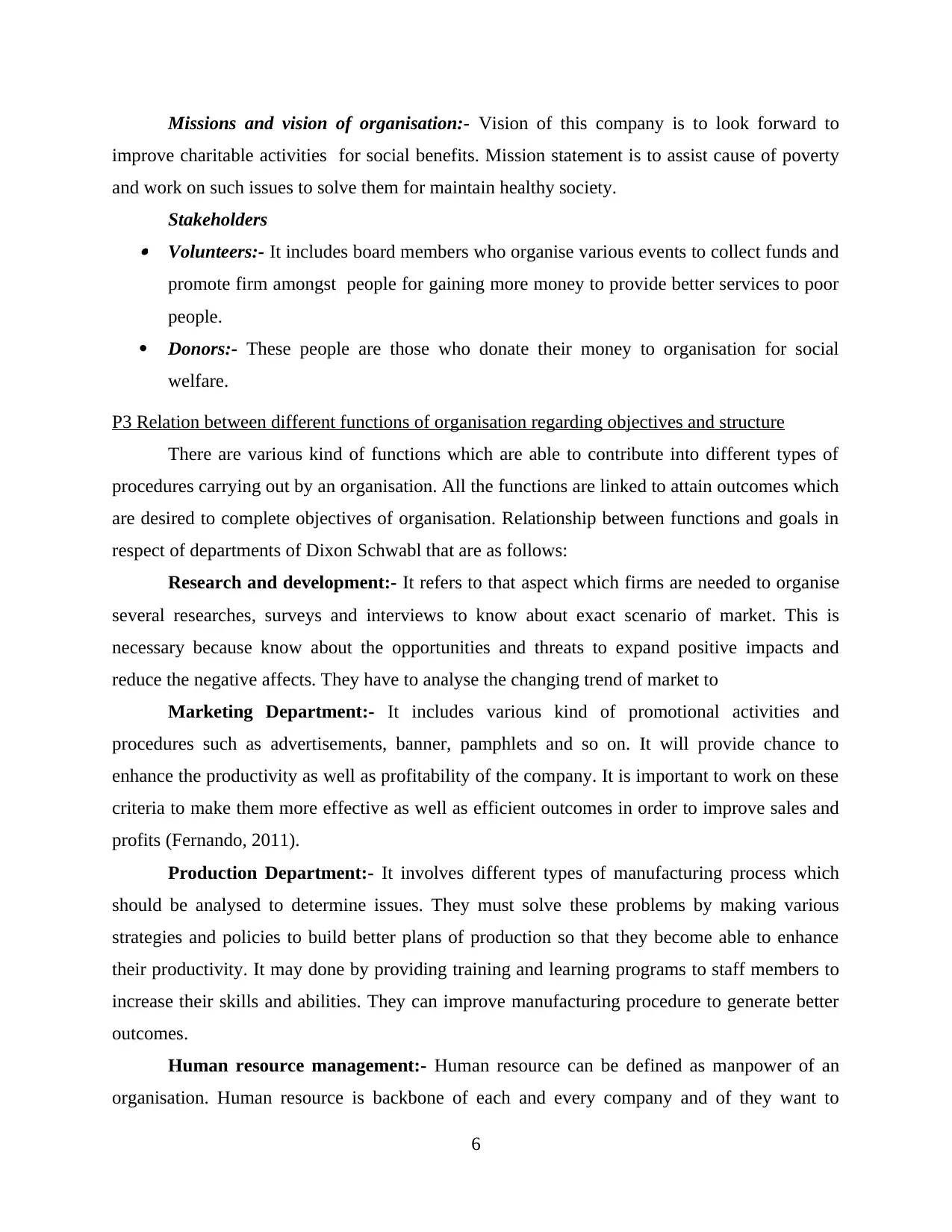
Missions and vision of organisation:- Vision of this company is to look forward to
improve charitable activities for social benefits. Mission statement is to assist cause of poverty
and work on such issues to solve them for maintain healthy society.
Stakeholders Volunteers:- It includes board members who organise various events to collect funds and
promote firm amongst people for gaining more money to provide better services to poor
people.
Donors:- These people are those who donate their money to organisation for social
welfare.
P3 Relation between different functions of organisation regarding objectives and structure
There are various kind of functions which are able to contribute into different types of
procedures carrying out by an organisation. All the functions are linked to attain outcomes which
are desired to complete objectives of organisation. Relationship between functions and goals in
respect of departments of Dixon Schwabl that are as follows:
Research and development:- It refers to that aspect which firms are needed to organise
several researches, surveys and interviews to know about exact scenario of market. This is
necessary because know about the opportunities and threats to expand positive impacts and
reduce the negative affects. They have to analyse the changing trend of market to
Marketing Department:- It includes various kind of promotional activities and
procedures such as advertisements, banner, pamphlets and so on. It will provide chance to
enhance the productivity as well as profitability of the company. It is important to work on these
criteria to make them more effective as well as efficient outcomes in order to improve sales and
profits (Fernando, 2011).
Production Department:- It involves different types of manufacturing process which
should be analysed to determine issues. They must solve these problems by making various
strategies and policies to build better plans of production so that they become able to enhance
their productivity. It may done by providing training and learning programs to staff members to
increase their skills and abilities. They can improve manufacturing procedure to generate better
outcomes.
Human resource management:- Human resource can be defined as manpower of an
organisation. Human resource is backbone of each and every company and of they want to
6
improve charitable activities for social benefits. Mission statement is to assist cause of poverty
and work on such issues to solve them for maintain healthy society.
Stakeholders Volunteers:- It includes board members who organise various events to collect funds and
promote firm amongst people for gaining more money to provide better services to poor
people.
Donors:- These people are those who donate their money to organisation for social
welfare.
P3 Relation between different functions of organisation regarding objectives and structure
There are various kind of functions which are able to contribute into different types of
procedures carrying out by an organisation. All the functions are linked to attain outcomes which
are desired to complete objectives of organisation. Relationship between functions and goals in
respect of departments of Dixon Schwabl that are as follows:
Research and development:- It refers to that aspect which firms are needed to organise
several researches, surveys and interviews to know about exact scenario of market. This is
necessary because know about the opportunities and threats to expand positive impacts and
reduce the negative affects. They have to analyse the changing trend of market to
Marketing Department:- It includes various kind of promotional activities and
procedures such as advertisements, banner, pamphlets and so on. It will provide chance to
enhance the productivity as well as profitability of the company. It is important to work on these
criteria to make them more effective as well as efficient outcomes in order to improve sales and
profits (Fernando, 2011).
Production Department:- It involves different types of manufacturing process which
should be analysed to determine issues. They must solve these problems by making various
strategies and policies to build better plans of production so that they become able to enhance
their productivity. It may done by providing training and learning programs to staff members to
increase their skills and abilities. They can improve manufacturing procedure to generate better
outcomes.
Human resource management:- Human resource can be defined as manpower of an
organisation. Human resource is backbone of each and every company and of they want to
6
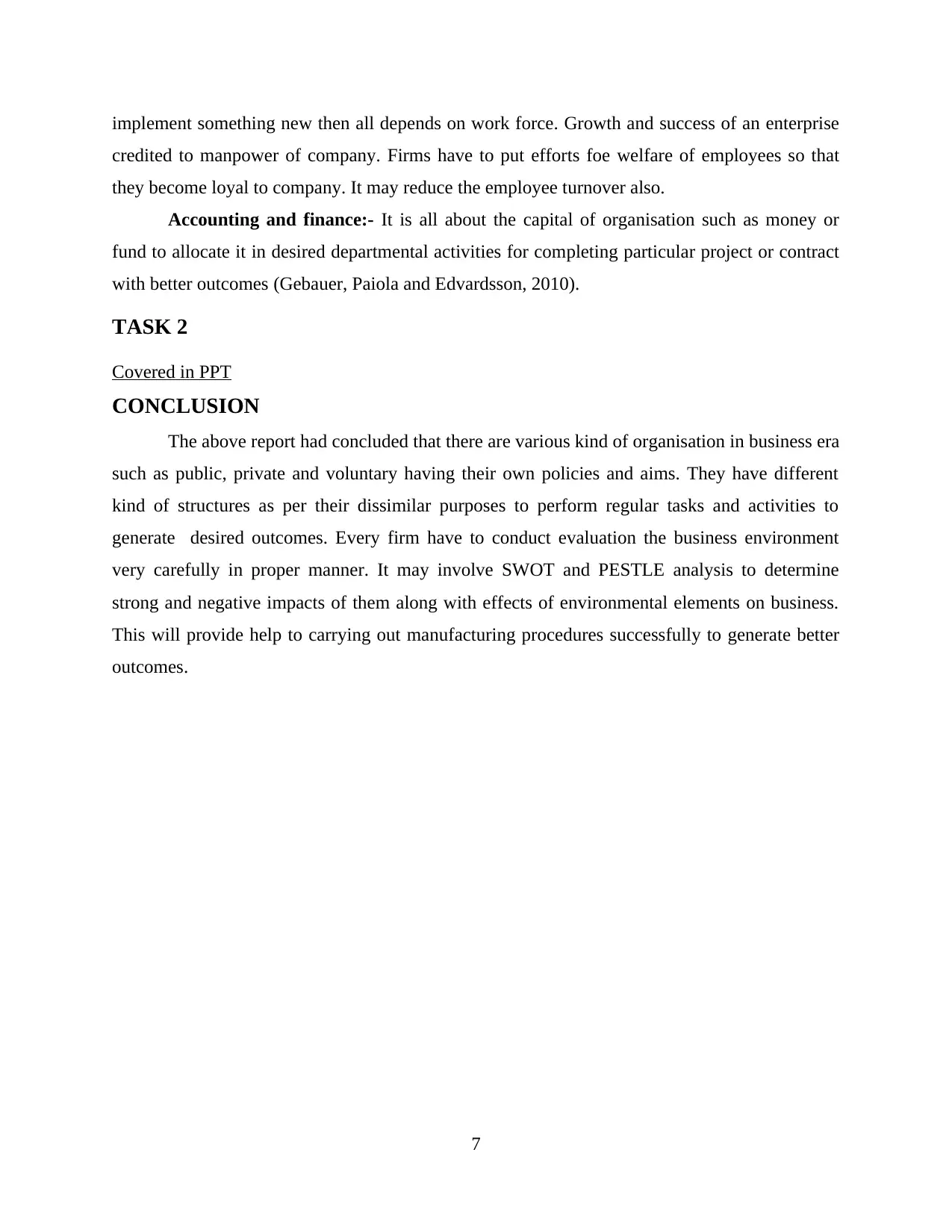
implement something new then all depends on work force. Growth and success of an enterprise
credited to manpower of company. Firms have to put efforts foe welfare of employees so that
they become loyal to company. It may reduce the employee turnover also.
Accounting and finance:- It is all about the capital of organisation such as money or
fund to allocate it in desired departmental activities for completing particular project or contract
with better outcomes (Gebauer, Paiola and Edvardsson, 2010).
TASK 2
Covered in PPT
CONCLUSION
The above report had concluded that there are various kind of organisation in business era
such as public, private and voluntary having their own policies and aims. They have different
kind of structures as per their dissimilar purposes to perform regular tasks and activities to
generate desired outcomes. Every firm have to conduct evaluation the business environment
very carefully in proper manner. It may involve SWOT and PESTLE analysis to determine
strong and negative impacts of them along with effects of environmental elements on business.
This will provide help to carrying out manufacturing procedures successfully to generate better
outcomes.
7
credited to manpower of company. Firms have to put efforts foe welfare of employees so that
they become loyal to company. It may reduce the employee turnover also.
Accounting and finance:- It is all about the capital of organisation such as money or
fund to allocate it in desired departmental activities for completing particular project or contract
with better outcomes (Gebauer, Paiola and Edvardsson, 2010).
TASK 2
Covered in PPT
CONCLUSION
The above report had concluded that there are various kind of organisation in business era
such as public, private and voluntary having their own policies and aims. They have different
kind of structures as per their dissimilar purposes to perform regular tasks and activities to
generate desired outcomes. Every firm have to conduct evaluation the business environment
very carefully in proper manner. It may involve SWOT and PESTLE analysis to determine
strong and negative impacts of them along with effects of environmental elements on business.
This will provide help to carrying out manufacturing procedures successfully to generate better
outcomes.
7
⊘ This is a preview!⊘
Do you want full access?
Subscribe today to unlock all pages.

Trusted by 1+ million students worldwide
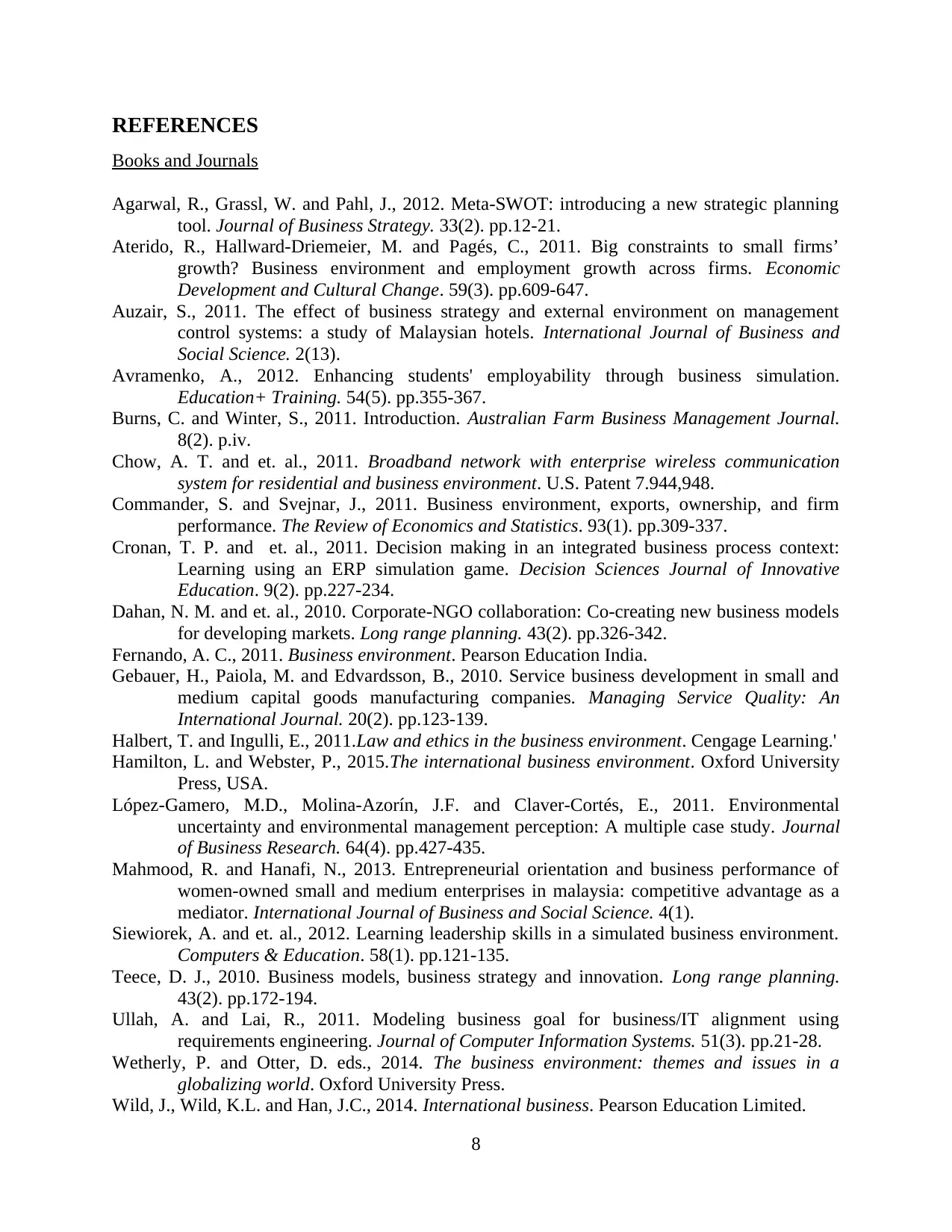
REFERENCES
Books and Journals
Agarwal, R., Grassl, W. and Pahl, J., 2012. Meta-SWOT: introducing a new strategic planning
tool. Journal of Business Strategy. 33(2). pp.12-21.
Aterido, R., Hallward-Driemeier, M. and Pagés, C., 2011. Big constraints to small firms’
growth? Business environment and employment growth across firms. Economic
Development and Cultural Change. 59(3). pp.609-647.
Auzair, S., 2011. The effect of business strategy and external environment on management
control systems: a study of Malaysian hotels. International Journal of Business and
Social Science. 2(13).
Avramenko, A., 2012. Enhancing students' employability through business simulation.
Education+ Training. 54(5). pp.355-367.
Burns, C. and Winter, S., 2011. Introduction. Australian Farm Business Management Journal.
8(2). p.iv.
Chow, A. T. and et. al., 2011. Broadband network with enterprise wireless communication
system for residential and business environment. U.S. Patent 7.944,948.
Commander, S. and Svejnar, J., 2011. Business environment, exports, ownership, and firm
performance. The Review of Economics and Statistics. 93(1). pp.309-337.
Cronan, T. P. and et. al., 2011. Decision making in an integrated business process context:
Learning using an ERP simulation game. Decision Sciences Journal of Innovative
Education. 9(2). pp.227-234.
Dahan, N. M. and et. al., 2010. Corporate-NGO collaboration: Co-creating new business models
for developing markets. Long range planning. 43(2). pp.326-342.
Fernando, A. C., 2011. Business environment. Pearson Education India.
Gebauer, H., Paiola, M. and Edvardsson, B., 2010. Service business development in small and
medium capital goods manufacturing companies. Managing Service Quality: An
International Journal. 20(2). pp.123-139.
Halbert, T. and Ingulli, E., 2011.Law and ethics in the business environment. Cengage Learning.'
Hamilton, L. and Webster, P., 2015.The international business environment. Oxford University
Press, USA.
López-Gamero, M.D., Molina-Azorín, J.F. and Claver-Cortés, E., 2011. Environmental
uncertainty and environmental management perception: A multiple case study. Journal
of Business Research. 64(4). pp.427-435.
Mahmood, R. and Hanafi, N., 2013. Entrepreneurial orientation and business performance of
women-owned small and medium enterprises in malaysia: competitive advantage as a
mediator. International Journal of Business and Social Science. 4(1).
Siewiorek, A. and et. al., 2012. Learning leadership skills in a simulated business environment.
Computers & Education. 58(1). pp.121-135.
Teece, D. J., 2010. Business models, business strategy and innovation. Long range planning.
43(2). pp.172-194.
Ullah, A. and Lai, R., 2011. Modeling business goal for business/IT alignment using
requirements engineering. Journal of Computer Information Systems. 51(3). pp.21-28.
Wetherly, P. and Otter, D. eds., 2014. The business environment: themes and issues in a
globalizing world. Oxford University Press.
Wild, J., Wild, K.L. and Han, J.C., 2014. International business. Pearson Education Limited.
8
Books and Journals
Agarwal, R., Grassl, W. and Pahl, J., 2012. Meta-SWOT: introducing a new strategic planning
tool. Journal of Business Strategy. 33(2). pp.12-21.
Aterido, R., Hallward-Driemeier, M. and Pagés, C., 2011. Big constraints to small firms’
growth? Business environment and employment growth across firms. Economic
Development and Cultural Change. 59(3). pp.609-647.
Auzair, S., 2011. The effect of business strategy and external environment on management
control systems: a study of Malaysian hotels. International Journal of Business and
Social Science. 2(13).
Avramenko, A., 2012. Enhancing students' employability through business simulation.
Education+ Training. 54(5). pp.355-367.
Burns, C. and Winter, S., 2011. Introduction. Australian Farm Business Management Journal.
8(2). p.iv.
Chow, A. T. and et. al., 2011. Broadband network with enterprise wireless communication
system for residential and business environment. U.S. Patent 7.944,948.
Commander, S. and Svejnar, J., 2011. Business environment, exports, ownership, and firm
performance. The Review of Economics and Statistics. 93(1). pp.309-337.
Cronan, T. P. and et. al., 2011. Decision making in an integrated business process context:
Learning using an ERP simulation game. Decision Sciences Journal of Innovative
Education. 9(2). pp.227-234.
Dahan, N. M. and et. al., 2010. Corporate-NGO collaboration: Co-creating new business models
for developing markets. Long range planning. 43(2). pp.326-342.
Fernando, A. C., 2011. Business environment. Pearson Education India.
Gebauer, H., Paiola, M. and Edvardsson, B., 2010. Service business development in small and
medium capital goods manufacturing companies. Managing Service Quality: An
International Journal. 20(2). pp.123-139.
Halbert, T. and Ingulli, E., 2011.Law and ethics in the business environment. Cengage Learning.'
Hamilton, L. and Webster, P., 2015.The international business environment. Oxford University
Press, USA.
López-Gamero, M.D., Molina-Azorín, J.F. and Claver-Cortés, E., 2011. Environmental
uncertainty and environmental management perception: A multiple case study. Journal
of Business Research. 64(4). pp.427-435.
Mahmood, R. and Hanafi, N., 2013. Entrepreneurial orientation and business performance of
women-owned small and medium enterprises in malaysia: competitive advantage as a
mediator. International Journal of Business and Social Science. 4(1).
Siewiorek, A. and et. al., 2012. Learning leadership skills in a simulated business environment.
Computers & Education. 58(1). pp.121-135.
Teece, D. J., 2010. Business models, business strategy and innovation. Long range planning.
43(2). pp.172-194.
Ullah, A. and Lai, R., 2011. Modeling business goal for business/IT alignment using
requirements engineering. Journal of Computer Information Systems. 51(3). pp.21-28.
Wetherly, P. and Otter, D. eds., 2014. The business environment: themes and issues in a
globalizing world. Oxford University Press.
Wild, J., Wild, K.L. and Han, J.C., 2014. International business. Pearson Education Limited.
8
Paraphrase This Document
Need a fresh take? Get an instant paraphrase of this document with our AI Paraphraser
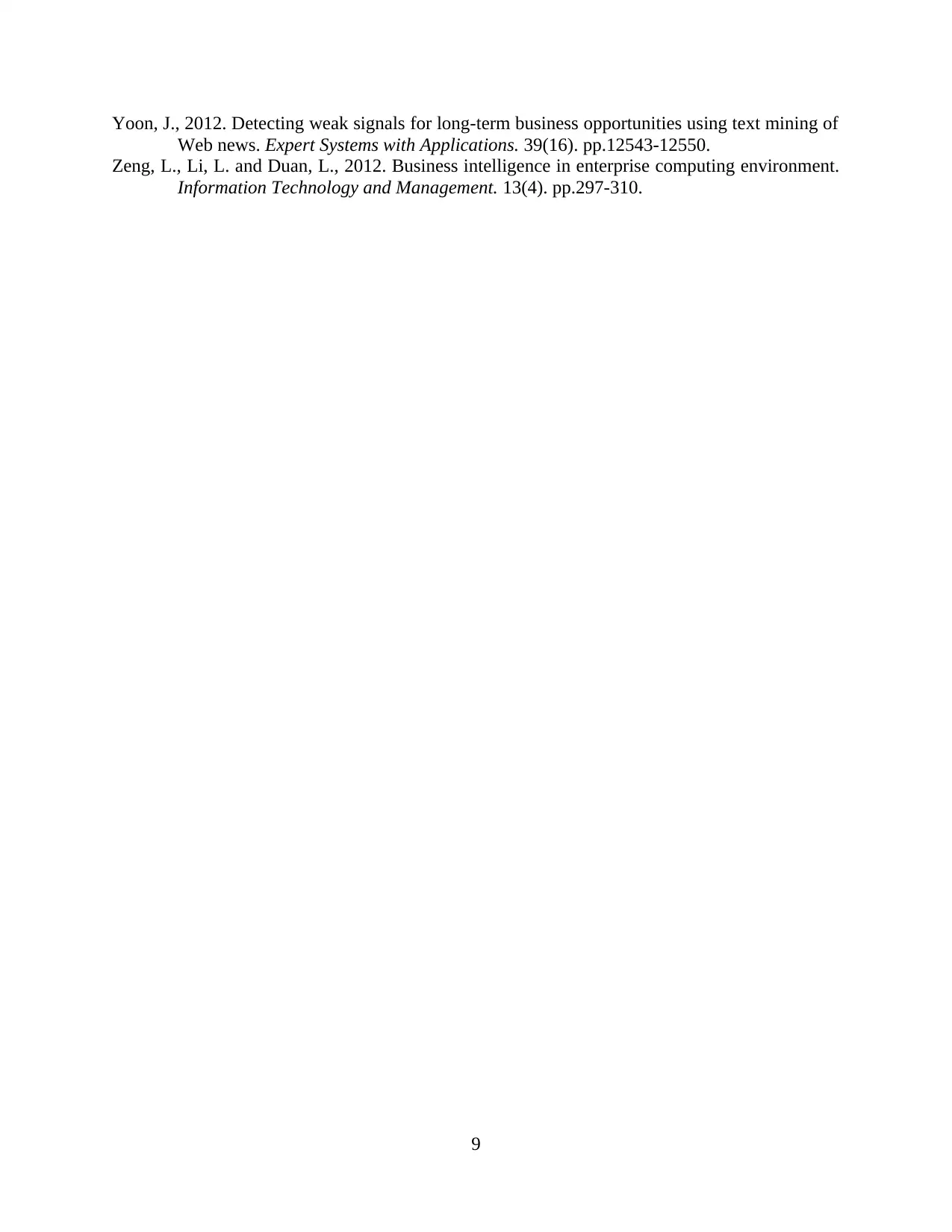
Yoon, J., 2012. Detecting weak signals for long-term business opportunities using text mining of
Web news. Expert Systems with Applications. 39(16). pp.12543-12550.
Zeng, L., Li, L. and Duan, L., 2012. Business intelligence in enterprise computing environment.
Information Technology and Management. 13(4). pp.297-310.
9
Web news. Expert Systems with Applications. 39(16). pp.12543-12550.
Zeng, L., Li, L. and Duan, L., 2012. Business intelligence in enterprise computing environment.
Information Technology and Management. 13(4). pp.297-310.
9
1 out of 11
Related Documents
Your All-in-One AI-Powered Toolkit for Academic Success.
+13062052269
info@desklib.com
Available 24*7 on WhatsApp / Email
![[object Object]](/_next/static/media/star-bottom.7253800d.svg)
Unlock your academic potential
Copyright © 2020–2025 A2Z Services. All Rights Reserved. Developed and managed by ZUCOL.




